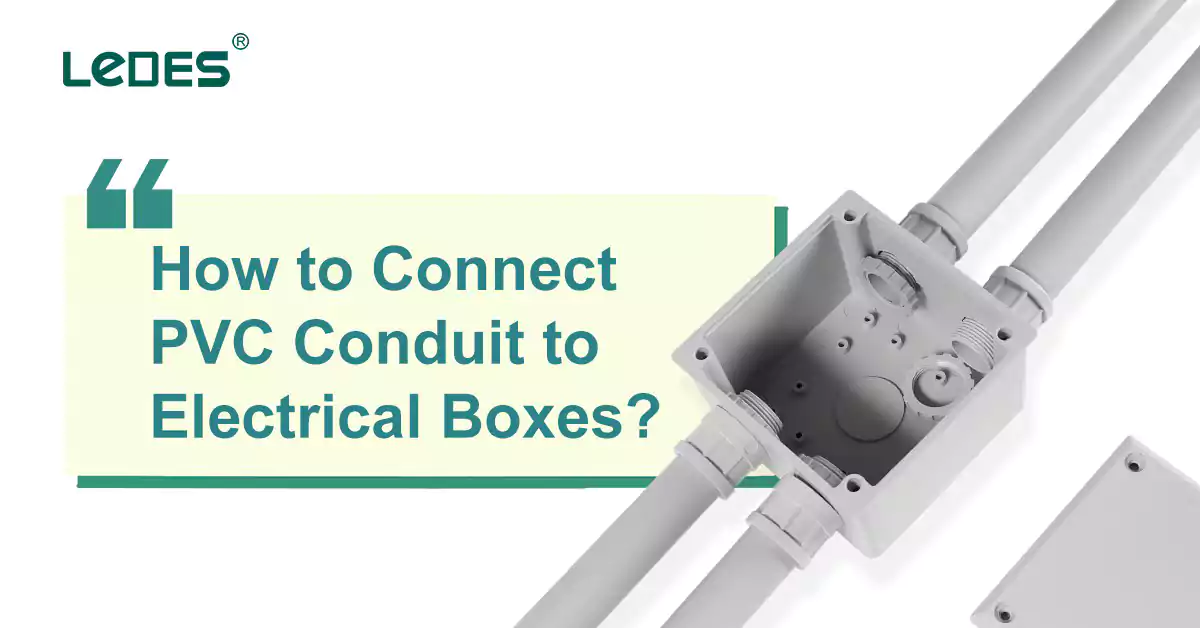
Tabla de contenido
Las instalaciones eléctricas requieren un enfoque meticuloso para garantizar un cableado adecuado y seguro. Un aspecto crucial de estas instalaciones es cómo conectar los conductos de PVC a las cajas eléctricas. Los conductos de PVC sirven como carcasa protectora para el cableado eléctrico, lo protegen de daños y le brindan una apariencia ordenada y prolija. En esta guía, exploraremos la importancia de conectar los conductos de PVC a las cajas eléctricas y le brindaremos un proceso paso a paso para realizar esta tarea de manera efectiva.
Conexión de conducto de PVC a cajas electricas Es un paso crítico en las instalaciones eléctricas por varias razones. En primer lugar, Proporciona una vía segura y cerrada para el cableado eléctrico, protegiéndolo de daños físicos, humedad y otros factores ambientales. El conducto actúa como una barrera, protegiendo los cables de posibles peligros y reduciendo el riesgo de descargas eléctricas o cortocircuitos.
En segundo lugar, La conexión de conductos de PVC a las cajas eléctricas garantiza una organización y gestión adecuadas del cableado eléctrico. Permite un enfoque estructurado y sistemático, lo que facilita la resolución de problemas, las reparaciones y las actualizaciones en el futuro. Al enrutar de forma ordenada los cables dentro del conducto y conectarlos a las cajas eléctricas adecuadas, crea un sistema eléctrico ordenado y accesible.
Por último, La conexión de conductos de PVC a cajas eléctricas cumple con los códigos y las normas eléctricas. Estos códigos están diseñados para promover estándares de seguridad y garantizar que las instalaciones eléctricas se realicen de acuerdo con las normas. La conexión adecuada de conductos a cajas eléctricas es una parte esencial para cumplir con estos requisitos y mantener un entorno eléctrico seguro.
En esta guía, profundizaremos en el proceso de conexión de conductos de PVC a cajas eléctricas. Exploraremos varios tipos de cajas eléctricas que se utilizan comúnmente en las instalaciones, incluidas las cajas de conexiones, las cajas de interruptores y las cajas de tomacorrientes. Además, consideraremos factores como el tipo de conducto (rígido o flexible) y los materiales utilizados en la construcción de las cajas (metálicas o no metálicas).
Si sigue las instrucciones paso a paso que se proporcionan, adquirirá los conocimientos y las habilidades necesarios para conectar conductos de PVC a cajas eléctricas con confianza. Tanto si es un aficionado al bricolaje como si es un electricista profesional, comprender este proceso es fundamental para garantizar un sistema eléctrico seguro y fiable.
Existen muchos tipos diferentes de cajas eléctricas y métodos para conectarles conductos de PVC. A continuación, se muestran algunos de los tipos de cajas eléctricas más utilizados.
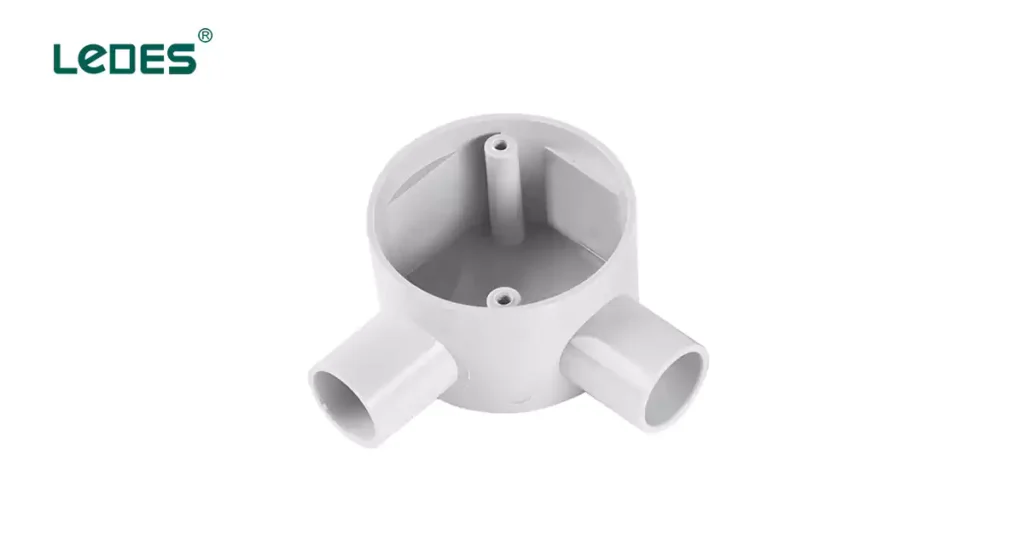
Cajas de conexionesLas cajas de conexiones, también llamadas cajas de terminales o cajas J, son recintos protectores que albergan y protegen las conexiones de cableado eléctrico y los empalmes de cables de los factores ambientales y el contacto accidental. Se instalan comúnmente en techos, paredes y yeso de hormigón. Actúan como un eje central donde se pueden unir de forma segura varios cables. Las cajas de conexiones son fundamentales para garantizar la seguridad eléctrica, organizar los cables y cumplir con los códigos y las regulaciones.
Al conectar conductos de PVC a cajas de conexiones, se deben tener en cuenta 3 factores:
Tamaño y compatibilidad del conducto: Asegúrese de que el tamaño del conducto de PVC coincida con los orificios o las aberturas de la caja de conexiones. Utilice conectores o accesorios diseñados específicamente para conductos de PVC para establecer una conexión segura.
Toma de tierra: Siga los códigos y las normas eléctricas para garantizar una conexión a tierra adecuada. En el caso de las cajas de conexiones metálicas, conecte el cable de conexión a tierra de forma segura a la caja. Esto ayuda a evitar riesgos eléctricos y garantiza el cumplimiento de las normas de seguridad.
Protección y sellado: Utilice ojales o casquillos adecuados en el lugar donde el conducto de PVC ingresa a la caja de conexiones para protegerlo de la abrasión o los daños. Considere sellar la conexión del conducto a la caja con compuestos de sellado o juntas para una mayor protección contra la humedad y los contaminantes.
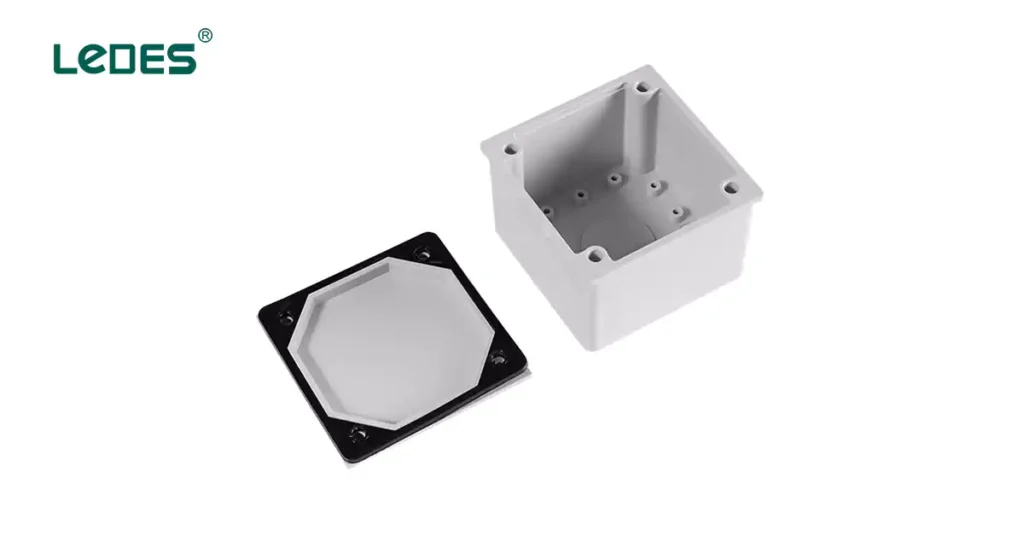
Una caja adaptable, también conocida como caja de conexiones adaptable o caja adaptable, es un tipo de caja eléctrica diseñada para alojar varios tipos de conductos, cables y conexiones de cableado. Estas cajas ofrecen flexibilidad y versatilidad en cuanto a los tipos y tamaños de conductos que pueden alojar, lo que las hace adecuadas para una amplia gama de instalaciones eléctricas.
Las cajas adaptables se utilizan comúnmente en aplicaciones eléctricas residenciales, comerciales e industriales donde se deben conectar múltiples conductos o cables o donde pueden requerirse modificaciones o ampliaciones futuras. Proporcionan una solución conveniente para enrutar y proteger el cableado eléctrico.
Un cuerpo de conducto es un conector que une los conductos de protección, lo que permite el paso de cables eléctricos entre ubicaciones. Viene en varios tipos, cada uno con su función única de redirección de cables. Sirve como un punto intermedio donde se pueden unir conductos, cambiar de dirección y acceder a ellos para fines de mantenimiento o tendido de cables. Los cuerpos de conducto desempeñan un papel fundamental para garantizar la gestión adecuada de los conductos, facilitar el enrutamiento de los cables y mantener el cumplimiento de los códigos y las regulaciones eléctricas.
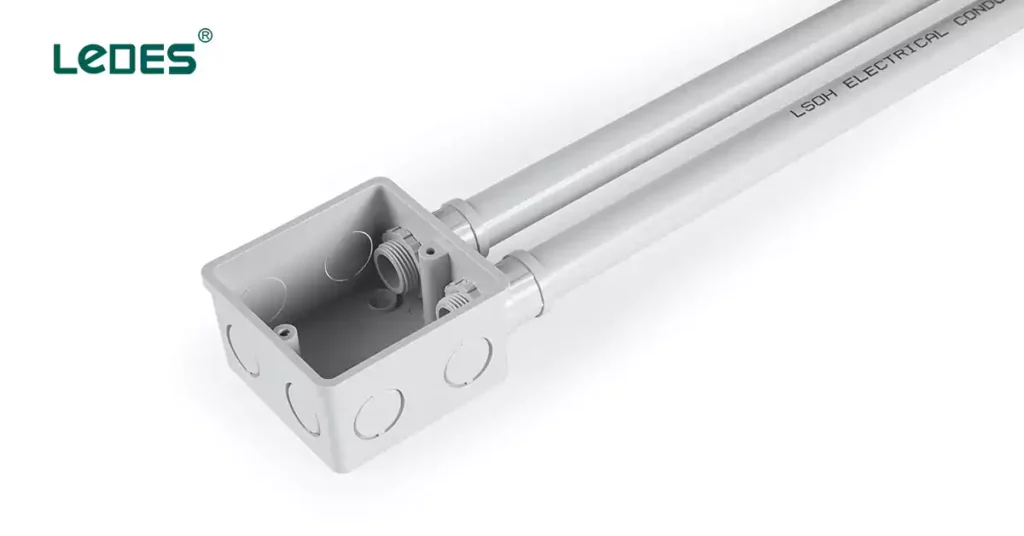
Una caja de interruptores es un gabinete eléctrico de metal o plástico, instalado dentro de las paredes, que alberga las partes funcionales de un interruptor de luz. Estas cajas brindan un espacio seguro y organizado para las conexiones eléctricas asociadas con interruptores y tomas de corriente.
Las cajas de interruptores vienen en varios diseños para adaptarse a diferentes necesidades de instalación:
Cajas de interruptores de una sola vía: Estas cajas son las más comunes y se utilizan para montar un único interruptor o tomacorriente. Proporcionan una solución compacta para instalaciones básicas.
Cajas de interruptores multipanel: Las cajas de interruptores multipanel se utilizan cuando es necesario instalar varios interruptores o tomas de corriente uno al lado del otro y tienen compartimentos separados para cada dispositivo. Garantizan una apariencia ordenada y organizada y simplifican la gestión del cableado.
Un caja de salida Es un recinto protector dentro de un sistema eléctrico donde se alojan los cables y se conectan a dispositivos como interruptores y electrodomésticos. Estas cajas brindan protección a las conexiones eléctricas y facilitan la instalación y el mantenimiento de los enchufes.
Cajas de salida de una sola vía: Estas cajas se utilizan habitualmente para montar una única toma o receptáculo. Ofrecen una solución compacta y eficiente para instalaciones básicas.
Cajas de salida de doble vía: Las cajas de doble entrada, de mayor tamaño, se utilizan cuando es necesario instalar varios tomacorrientes o receptáculos uno al lado del otro. Ofrecen compartimentos separados para cada tomacorriente, lo que garantiza una apariencia ordenada y organizada.
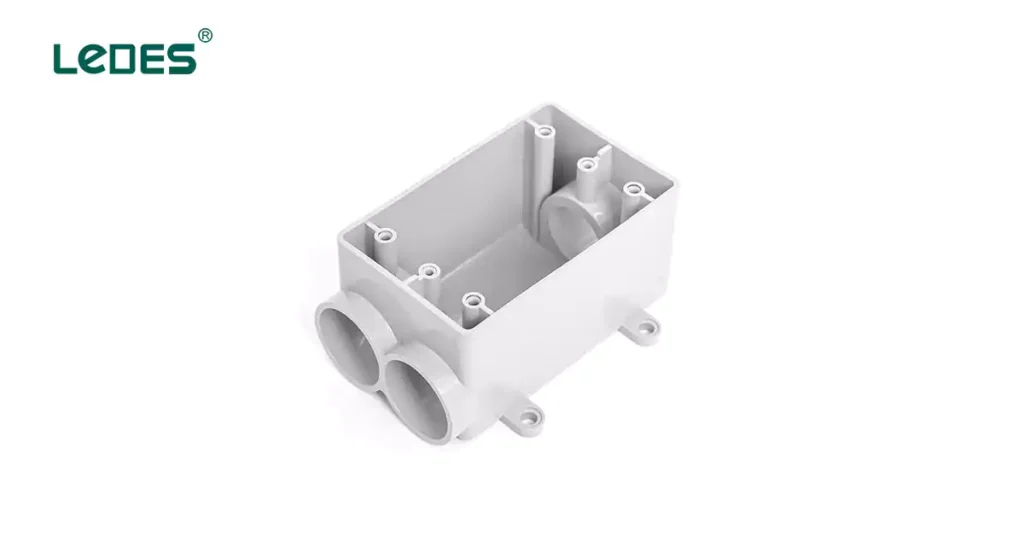
A caja de pandillas Es un gabinete eléctrico, generalmente de plástico o metal, que se monta sobre una superficie para albergar y proteger un grupo de dispositivos eléctricos, como interruptores y tomas de corriente. Proporciona un gabinete seguro y organizado para el cableado y las conexiones eléctricas, protegiéndolos de daños y proporcionando un medio de fácil acceso para realizar tareas de mantenimiento o modificaciones.
La conexión de un conducto de PVC a una caja eléctrica requiere una atención especial para garantizar una conexión segura y confiable. Enumeramos tres formas diferentes de conexión para conductos rígidos y conductos flexibles. Puede seguir estos pasos para conectar un conducto de PVC a una caja eléctrica:
Reúna las herramientas y materiales necesarios:
- Conducto de PVC y conectores adecuados
- Contratuercas, bujes, conectores roscados, accesorios de compresión o conectores a presión
Destornillador, llave inglesa o herramientas adecuadas
- Compuesto o cinta para roscas (si se utilizan conexiones roscadas)
Asegúrese de que la caja eléctrica esté correctamente instalada y conectada a tierra:
- Asegúrese de que la caja eléctrica esté montada de forma segura y conectada a tierra adecuadamente de acuerdo con los códigos y regulaciones eléctricas aplicables.
- Compruebe que la caja sea adecuada para el uso previsto y compatible con las conexiones de conductos de PVC.
Verificar tamaño y tipo:
- Asegúrese de que el diámetro del conducto de PVC coincida con los orificios o conectores de la caja eléctrica.
- Confirme que la caja eléctrica esté diseñada para el tipo específico de conducto de PVC que se utiliza (rígido o flexible).
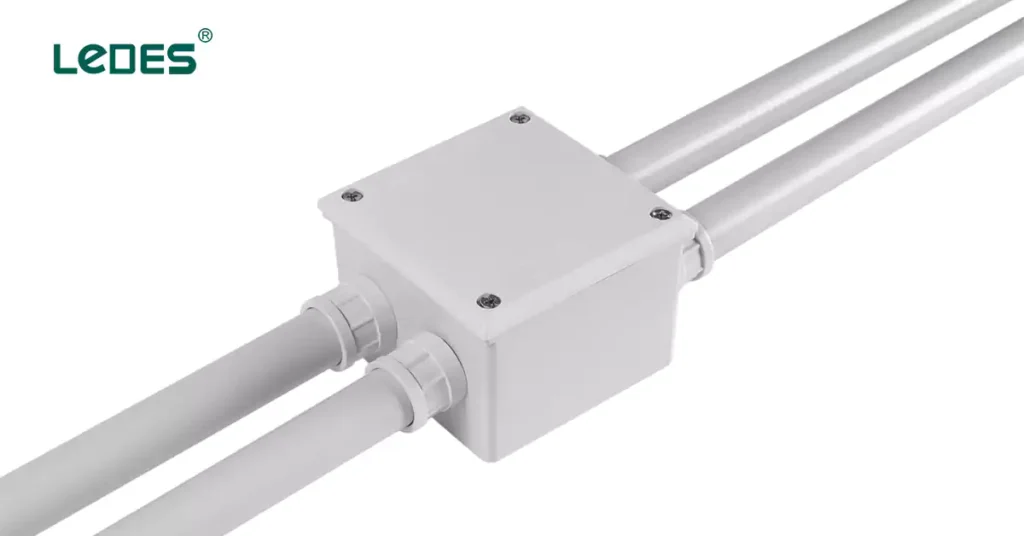
Las cajas que suelen estar diseñadas con orificios precortados se suelen utilizar con conductos de PVC rígidos, como las cajas adaptables y las cajas de interruptores. Para estas cajas, a continuación se ofrece una guía general para conectarlas con conductos de PVC:
- Reúne los materiales necesarios: Necesitará conductos de PVC, conectores de PVC, cemento para PVC, una sierra para metales o un cortador de PVC, un cuchillo multiusos, un destornillador y una caja de interruptores.
- Medir y cortar el conducto de PVC: Mida la longitud del conducto necesario para conectar la caja de distribución a la ubicación deseada. Utilice una sierra para metales o un cortador de PVC para cortar el conducto a la longitud adecuada. Asegúrese de que el corte sea recto y limpio.
- Prepare los extremos del conducto: Utilice un cúter para eliminar las rebabas o los bordes ásperos de los extremos cortados del conducto. Esto garantizará un ajuste adecuado al conectar el conducto a la caja de interruptores.
- Coloque los conectores de PVC: Deslice los conectores de PVC (como los adaptadores) en cada extremo del conducto. Los conectores deben encajar perfectamente en los extremos del conducto.
- Aplicar cemento para PVC: Aplique cemento para PVC en el interior de cada conector y en el exterior de los extremos de los conductos. Asegúrese de seguir las instrucciones del cemento para PVC en cuanto al tiempo de secado y la aplicación.
- Inserte el conducto en la caja del interruptor: Ubique el orificio ciego en la caja del interruptor que se alinea con el conducto. Inserte con cuidado un extremo del conducto en el orificio ciego. Empújelo con firmeza hasta que quede completamente asentado en la caja.
- Asegure el conducto: Dentro de la caja de interruptores, use un destornillador para apretar los tornillos de los conectores de PVC. Esto asegurará el conducto en su lugar y proporcionará un sellado hermético.
- Repita para conexiones de conductos adicionales: Si necesita conectar varios conductos a la caja de interruptores, repita los pasos 2 a 7 para cada conducto.
- Probar la conexión: Una vez que se hayan realizado todas las conexiones de los conductos, verifique que estén bien fijados y correctamente colocados en la caja de distribución. Asegúrese de que no haya piezas sueltas ni espacios vacíos.
- Continúe con el cableado: Con el conducto conectado de forma segura a la caja de interruptores, puede continuar con el cableado según sea necesario, siguiendo los códigos y regulaciones eléctricas.
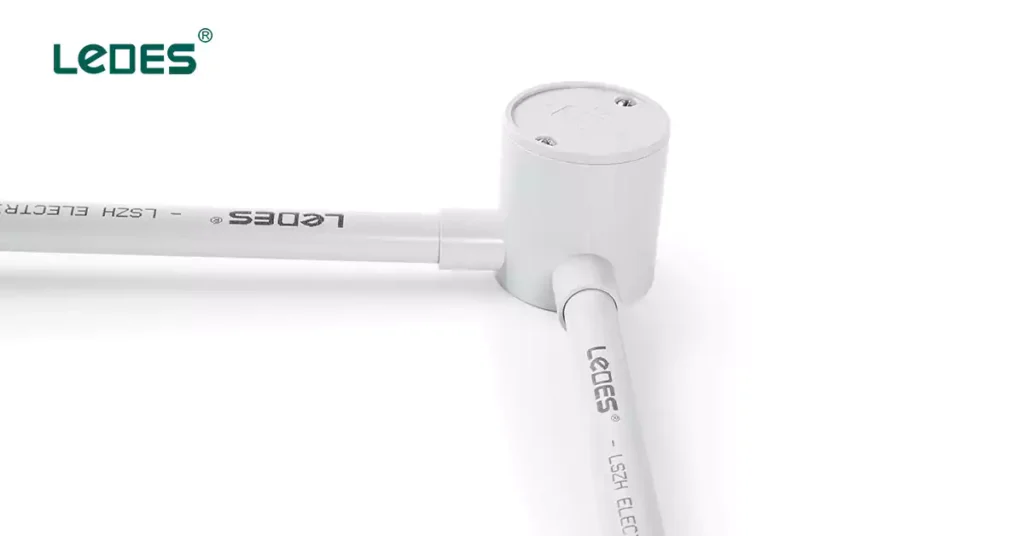
Las cajas eléctricas, como las cajas de conexiones y los cuerpos de conductos que están diseñados con concentradores en la caja, se pueden conectar directamente con conductos de PVC rígido usando solo cemento solvente de PVC; estos son los pasos de la conexión.
- Medir y cortar el conducto de PVC: Mida y corte el conducto de PVC a la longitud deseada con una sierra para metales o un cortador de PVC. Asegúrese de que el conducto esté cortado en ángulo recto para crear un extremo limpio y recto.
- Eliminar las rebabas: Utilice un cúter o una herramienta desbarbadora para eliminar las rebabas o los bordes ásperos del extremo cortado del conducto. Esto ayudará a garantizar un ajuste adecuado y una conexión segura.
- Limpiar el conducto y la caja: Limpie el exterior del conducto y el interior de la caja eléctrica (como la caja de conexiones y el cuerpo del conducto) con un paño limpio para eliminar la suciedad, el polvo o los residuos. Esto ayudará a garantizar una superficie limpia para que el cemento de PVC se adhiera de manera eficaz.
- Aplicar imprimación de PVC (si es necesario):Algunos fabricantes de cemento para PVC recomiendan aplicar una imprimación para PVC tanto al conducto como a la caja antes de aplicar el cemento. La imprimación ayuda a limpiar y preparar las superficies para una mejor adhesión. Consulte las instrucciones del fabricante para determinar si es necesaria la aplicación de imprimación.
- Aplicar cemento para PVC: Aplique una cantidad generosa de cemento para PVC en el exterior del extremo del conducto, cubriendo aproximadamente de 5 a 7,5 cm (2 a 3 pulgadas) de la longitud del conducto. Además, aplique cemento para PVC en el interior de la abertura del cubo de la caja.
- Inserte el conducto en la caja: Inserte firmemente el conducto en la abertura del cubo de la caja, asegurándose de que quede bien ajustado y seguro. Gire el conducto ligeramente para distribuir uniformemente el cemento y crear una unión fuerte entre el conducto y el cuerpo.
- Mantener en su lugar: Mantenga el conducto en su lugar durante unos segundos para permitir que el cemento para PVC se endurezca y cree una conexión sólida. Siga el tiempo de curado recomendado por el fabricante para el cemento para PVC.
- Repita para conexiones de conductos adicionales: Si conecta varios conductos al mismo cuerpo del conducto, repita los pasos 1 a 7 para cada conducto.
- Permitir un curado adecuado: Después de completar las conexiones, deje suficiente tiempo para que el cemento de PVC se cure completamente de acuerdo con las recomendaciones del fabricante antes de someter la instalación a tensión o tirar de los conductos.
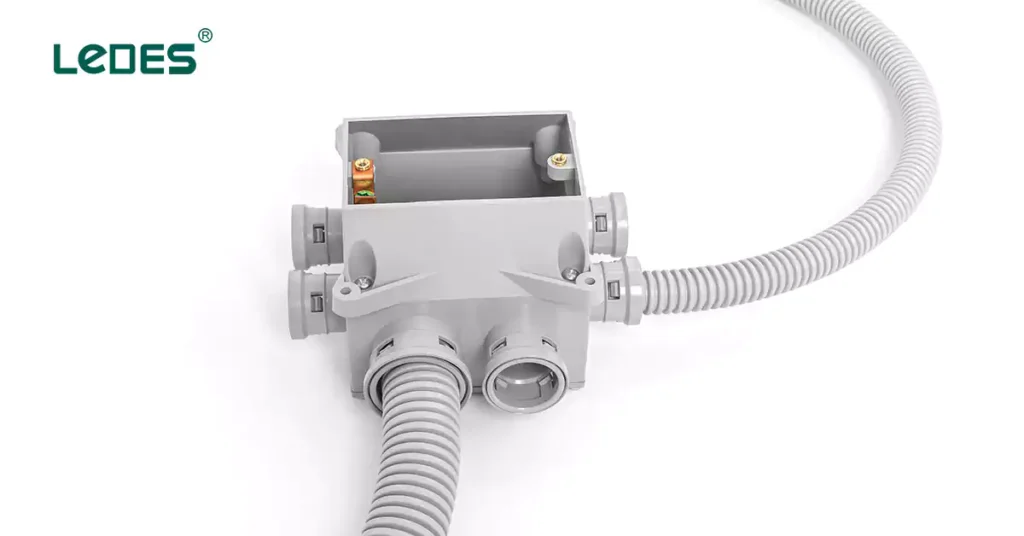
Las cajas eléctricas diseñadas con lengüetas, como las cajas de conexiones y las cajas de techo, normalmente se conectan con conductos flexibles y corrugados; la conexión de estas cajas no requiere herramientas ni conectores adicionales. A continuación, se ofrece una guía general para conectarlas a conductos y tubos flexibles de PVC.
- Prepare el conducto corrugado: Mida y corte el conducto corrugado a la longitud deseada con una sierra para metales o un cortador de conductos. Asegúrese de que el conducto esté cortado en ángulo recto para crear un extremo limpio y recto.
- Inspeccione la caja eléctrica: Revise la caja (como las cajas de conexiones y los techos) para detectar daños o defectos. Asegúrese de que las pestañas o los conectores de la caja estén intactos y en buenas condiciones para una conexión adecuada.
- Alinee el conducto con la caja: Sujete el extremo cortado del conducto corrugado contra las lengüetas o conectores de la caja. Asegúrese de que el conducto esté correctamente alineado para que encaje de forma segura en la caja.
- Empuje el conducto sobre la caja: Aplique una presión firme y uniforme para empujar el conducto hacia las pestañas o conectores de la caja. Debe deslizarse o encajar en su lugar, creando una conexión segura.
- Compruebe la conexión: Inspeccione la conexión para asegurarse de que el conducto esté bien sujeto a la caja. Verifique que las lengüetas o conectores se hayan acoplado a las corrugaciones del conducto, lo que proporciona una conexión firme y confiable.
- Repita para conexiones de conductos adicionales: Si conecta varios conductos a la misma caja, repita los pasos 1 a 5 para cada conducto.
- Asegúrese de que la alineación y el asiento sean correctos: Confirme que todos los conductos estén correctamente alineados y colocados en las pestañas o conectores de la caja. Esto ayudará a garantizar una conexión segura y confiable para toda la instalación.
Si sigue estos pasos, podrá conectar con éxito un conducto de PVC a una caja eléctrica, lo que garantizará una instalación eléctrica segura y confiable. Es importante seguir los códigos y las normas eléctricas y consultar las instrucciones del fabricante para la caja de conductos y el conducto corrugado específicos que esté utilizando. Si no está seguro o no tiene experiencia en trabajos eléctricos, se recomienda buscar la ayuda de un electricista calificado.
Las cajas eléctricas de plástico y metal tienen sus aplicaciones correspondientes. Las cajas de conexiones de plástico y de cable Romex suelen combinarse, en particular para tomas de corriente interiores, aunque las cajas de metal también pueden ser adecuadas según el proyecto. El uso de conductos de metal con cajas de plástico suele ser inseguro y contradice los códigos eléctricos.
Si bien el PVC puede derretirse cuando se calienta demasiado, no conduce la electricidad como el metal. Utilice cajas de plástico cuando entren o salgan cables no metálicos de la caja, ya que los cables con revestimiento metálico requieren una conexión a tierra con una caja eléctrica de metal y no deben utilizarse en cajas de plástico.
Exploremos los escenarios en los que comúnmente se utilizan cajas eléctricas de plástico o metal y analicemos sus ventajas y desventajas.
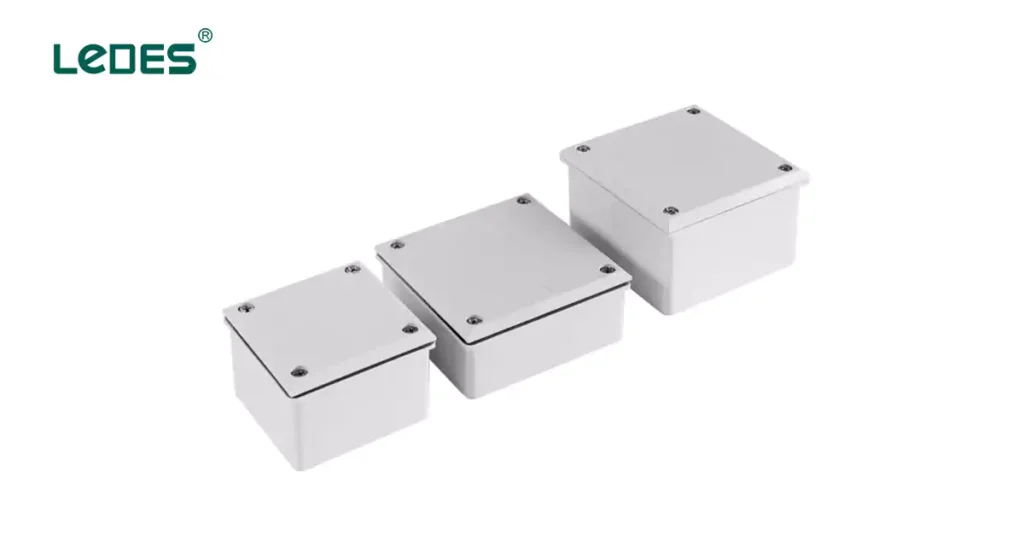
Las cajas eléctricas de plástico, generalmente hechas de PVC o policarbonato, ofrecen varios beneficios que las hacen adecuadas para diversas instalaciones.
Ventajas:
No conductor: Las cajas de plástico no son conductoras, lo que significa que no conducen electricidad. Esta propiedad las hace ideales para situaciones en las que es necesario minimizar la conductividad, como en entornos húmedos o corrosivos.
Facilidad de instalación: Las cajas de plástico son ligeras y fáciles de manipular. Se pueden instalar rápidamente con clavos, tornillos o adhesivos. Su flexibilidad permite realizar ajustes y modificaciones de forma sencilla.
Económico: Las cajas de plástico suelen ser más económicas que sus contrapartes de metal. Esta asequibilidad las convierte en una opción popular para aplicaciones residenciales y proyectos con limitaciones presupuestarias.
Resistencia a la corrosión: El plástico es resistente a la corrosión, lo que hace que las cajas eléctricas de plástico sean adecuadas para instalaciones al aire libre o áreas expuestas a la humedad.
Contras:
Fuerza limitada: Las cajas de plástico pueden no ser tan resistentes como las de metal, lo que puede afectar su idoneidad para aplicaciones de trabajo pesado o ubicaciones propensas a impactos físicos.
Resistencia al calor limitada: El plástico puede no soportar altas temperaturas tan bien como el metal. Por lo tanto, las cajas de plástico generalmente no se recomiendan para instalaciones que involucran dispositivos de alto voltaje o que producen calor.
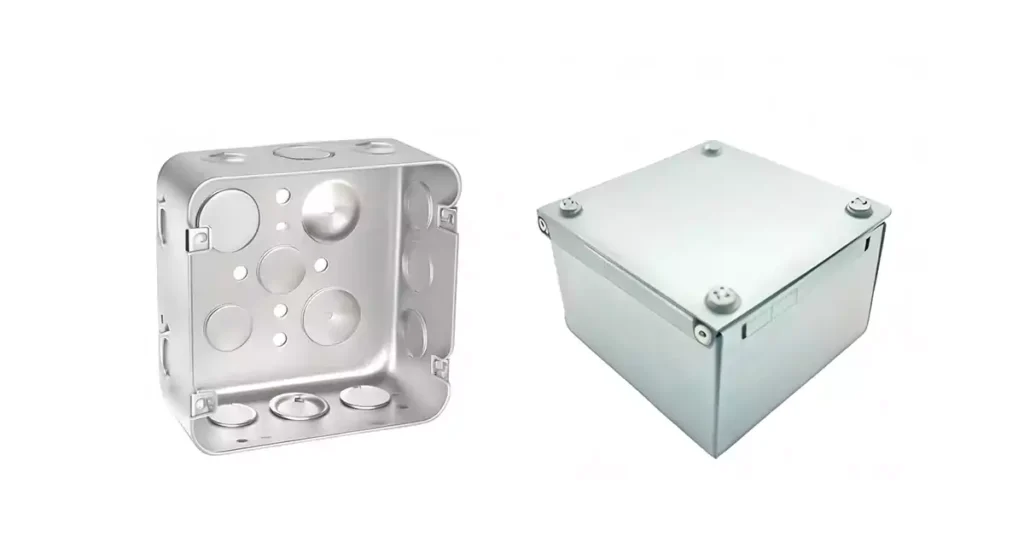
Las cajas eléctricas metálicas, normalmente hechas de acero o aluminio, ofrecen ventajas distintivas que las hacen adecuadas para aplicaciones específicas:
Ventajas:
Durabilidad y resistencia: Las cajas de metal son muy duraderas y brindan una excelente protección para las conexiones eléctricas. Son menos propensas a sufrir daños por impactos, lo que las hace adecuadas para entornos industriales o comerciales.
Resistencia al calor: Las cajas de metal pueden soportar temperaturas más altas mejor que las de plástico, lo que las hace adecuadas para aplicaciones que involucran dispositivos que producen calor o circuitos de alto voltaje.
Capacidad de puesta a tierra: Las cajas de metal brindan capacidades inherentes de conexión a tierra debido a su naturaleza conductora. Esto las hace necesarias para los requisitos de conexión a tierra en ciertas instalaciones.
Contras:
Conductividad: Las cajas de metal conducen electricidad, lo que puede suponer riesgos de seguridad si no están correctamente conectadas a tierra. Se debe tener cuidado de asegurarse de que la caja esté correctamente conectada a tierra para evitar descargas eléctricas.
Potencial de corrosión: Si se exponen a la humedad o a elementos corrosivos, las cajas de metal pueden oxidarse o corroerse con el tiempo. Se deben considerar medidas de protección adecuadas, como el uso de revestimientos resistentes a la corrosión o cajas de acero inoxidable, para entornos exteriores o húmedos.
Costo: Las cajas de metal son generalmente más caras que las de plástico debido al material y los procesos de fabricación involucrados.
En resumen, aquí se presentan algunos escenarios comunes en los que normalmente se utilizan cajas eléctricas de plástico o metal:
Cajas eléctricas de plástico: Aplicaciones residenciales, ambientes interiores secos, proyectos sensibles a los costos, requisitos no conductores e instalaciones donde la resistencia a la corrosión es esencial.
Cajas eléctricas metálicas: Aplicaciones comerciales o industriales, instalaciones al aire libre, entornos con altas temperaturas, requisitos de conexión a tierra y ubicaciones que exigen mayor durabilidad y resistencia al impacto.
Al elegir entre cajas eléctricas de plástico y de metal, tenga en cuenta los requisitos específicos de instalación, el presupuesto, las condiciones ambientales y la carga eléctrica involucrada. Siempre respete los códigos y las normas eléctricas locales para garantizar una instalación segura y que cumpla con las normas.
Al trabajar con sistemas eléctricos, la seguridad debe ser la máxima prioridad. Las instalaciones eléctricas implican riesgos inherentes y tomar las precauciones necesarias es crucial para el bienestar tanto del instalador como de los ocupantes del edificio. A continuación, se indican algunas consideraciones de seguridad clave que se deben tener en cuenta:
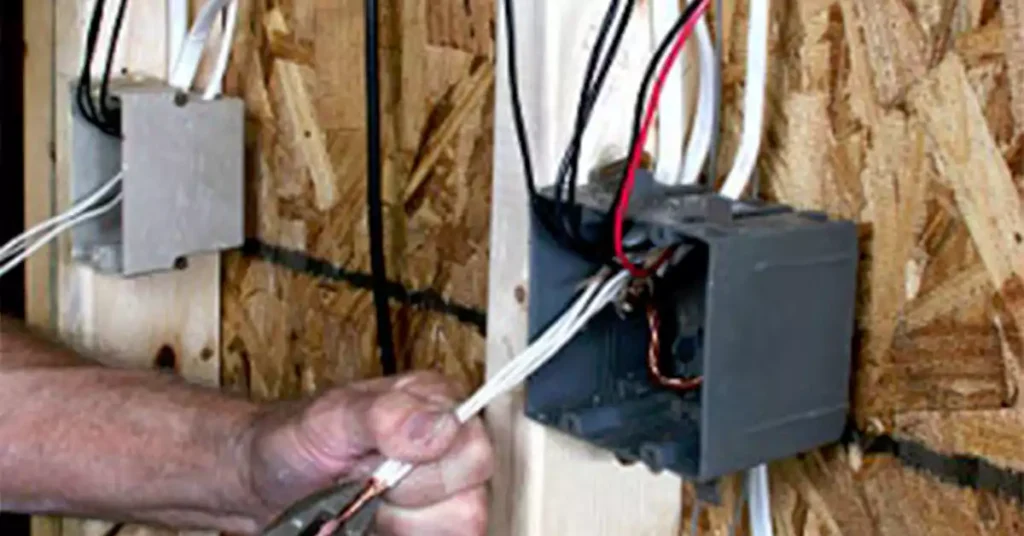
Trabajar con electricidad conlleva peligros inherentes, como descargas eléctricas, quemaduras y riesgo de incendio. Es fundamental conocer estos riesgos y tomar las precauciones de seguridad adecuadas durante todo el proceso de instalación. Algunas medidas de seguridad importantes que se deben seguir son:
- Use equipo de protección personal (EPP): use siempre EPP adecuado, como guantes aislantes, gafas de seguridad y ropa protectora, para protegerse contra peligros eléctricos.
- Asegúrese de que sea competente: los trabajos eléctricos deben ser realizados por personas con conocimientos, formación y experiencia en instalaciones eléctricas. Si no está seguro de algún aspecto del trabajo, consulte a un electricista calificado.
- Mantenga un entorno de trabajo seguro: mantenga el área de trabajo limpia, ordenada y libre de posibles peligros. Evite trabajar cerca de fuentes de agua o en condiciones húmedas.
- Utilice herramientas y equipos adecuados: utilice herramientas aisladas diseñadas específicamente para trabajos eléctricos. Inspeccione las herramientas periódicamente para detectar posibles daños y reemplácelas si es necesario.
Antes de realizar cualquier conexión a las cajas eléctricas, es fundamental desconectar el suministro eléctrico del circuito o del área donde se realizará el trabajo. Esta precaución es esencial para evitar descargas eléctricas y lesiones. Siga estos pasos al desconectar el suministro eléctrico:
- Identifique el disyuntor o fusible correcto que controla la energía del área específica donde se realizará el trabajo.
- Apague el disyuntor o retire el fusible, asegurándose de que la energía esté completamente desconectada.
- Utilice un comprobador de voltaje para verificar que no haya voltaje eléctrico presente en el circuito o los cables antes de continuar con cualquier trabajo.
Para garantizar la seguridad y el cumplimiento de las instalaciones eléctricas, es fundamental seguir los códigos y las normas eléctricas locales. Estos códigos proporcionan pautas para la instalación, la conexión a tierra y otras medidas de seguridad adecuadas. A continuación, se indican algunos puntos clave que se deben tener en cuenta:
- Familiarícese con los códigos y las normas eléctricas aplicables en su área. Estos códigos pueden variar según la jurisdicción.
- Cumplir con las pautas para la selección e instalación de cajas eléctricas, conductos, conectores y otros componentes.
- Asegúrese de que las cajas eléctricas estén correctamente conectadas a tierra según los requisitos establecidos en los códigos eléctricos. Una conexión a tierra incorrecta puede provocar peligros eléctricos y daños en los equipos.
- Inspeccionar y mantener periódicamente las instalaciones eléctricas para garantizar que cumplan con los últimos códigos y regulaciones.
En conclusión, las cajas eléctricas están en todas partes y son esenciales en las instalaciones eléctricas. Hay muchos tipos diferentes de cajas eléctricas y cada tipo puede tener diferentes requisitos de instalación, por lo que la instalación adecuada de las cajas eléctricas es crucial para la seguridad y la funcionalidad de los sistemas eléctricos. Ya sea que se utilicen cajas eléctricas de plástico o de metal, es esencial comprender sus ventajas, limitaciones y aplicaciones adecuadas. Si sigue las pautas y precauciones de seguridad recomendadas, y también cumple con las regulaciones locales, puede garantizar una instalación exitosa y minimizar el riesgo de peligros eléctricos.
Cualquier pregunta sobre la solución del sistema eléctrico, Por favor contáctenos en cualquier momento.




